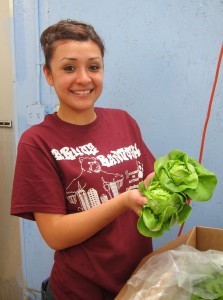Food Justice Empowers Teenagers

Originally appears in the Summer 2012 issue
Our school’s neighborhood is steeped in the history of Italian farmers tilling the land. Now, we’re experiencing an influx of immigrants from rural Mexico and Latin America, many of whom were once farmers. And yet, many of my freshmen are hungry at lunchtime. Many of those with food eat Cheetos and drink Gatorade.
There are countless reasons and histories behind why good, nutritious food is lacking from my students’ diets. What I can tell you is what my students and I did about it. We married two purposes: increased access to healthy food and academic success. Food is immediately tangible and relevant to students’ daily lives. By addressing students’ desire for better food, we could also move towards more abstract goals: attaining the skills for success in high school and beyond. In what follows, I will share how we did this in the hopes that the unit and materials provided here are useful to your school community.
For many of my students, generational poverty makes academic success difficult, and college seem unattainable. Skill level gaps start widening during middle school, and if students fail their freshman year, many do not return to high school. The freshmen who participated in the food justice unit saw their skills grow as they worked on addressing the issues of poverty and food injustice in their own lives. Hopefully high engagement learning helps students stay in school.
To view the photo-rich magazine version, click here.
If you are not already a subscriber, please subscribe to read the full article
Gwendolyn Eden is from rural Nebraska and now happily teaches language arts in Thornton, CO. Eden thrills at the opportunity to integrate scientific and social studies content into her language arts classroom, she is passionate about improving mentoring opportunities for teachers, and she is an avid gardening.
Leave a Reply
You must be logged in to post a comment.





